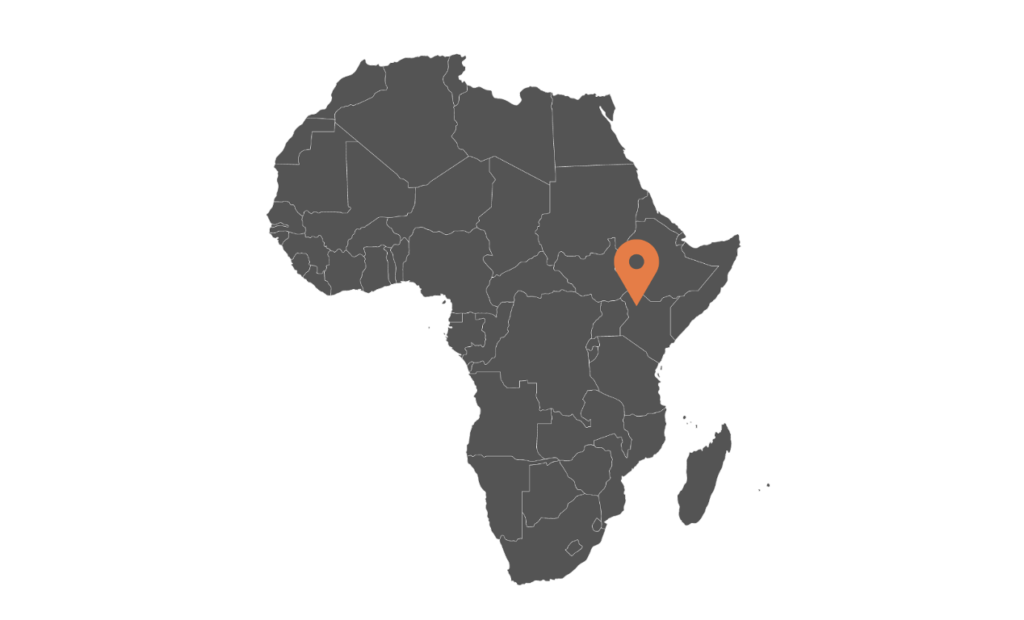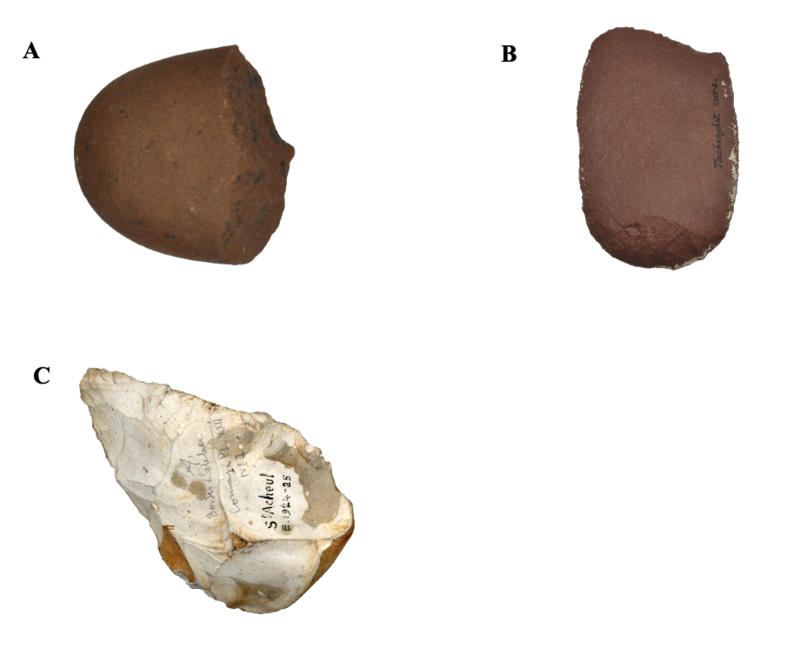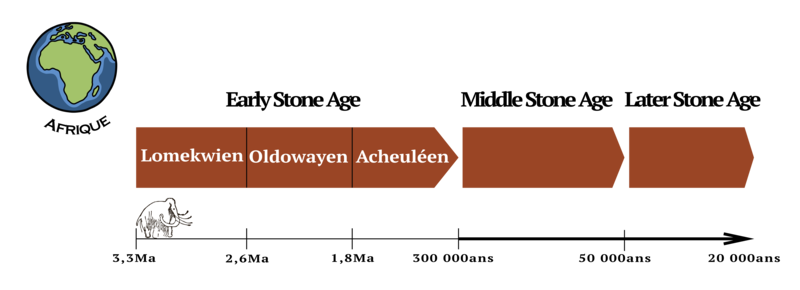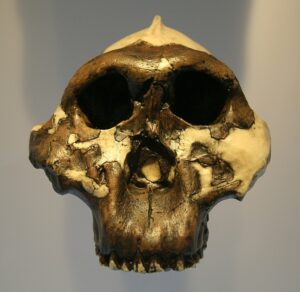Periodization in Africa
Prehistory in Africa, a continent sometimes called the cradle of humanity, is subdivided into three periods according to different lithic industries: the Early Stone Age (ESA), the Middle Stone Age (MSA), and the Later Stone Age (LSA).
This periodization begins about 3.3 million years ago (later abbreviated to Ma), the estimated age of the first tools discovered at Lomekwi, a complex of prehistoric sites located on the shore of Lake Turkana in Kenya.

The name Lomekwien refers to this lithic industry characterized by large tools. The biggest ones weigh 15 kg! It was not therefore the genus Homo, which emerged at the earliest around 2.8-2.5 Ma, who created these first tools.
The lithic industry called the Oldowayen succeeds the Lomekwien. It is characterized by the shaping of pebbles known as arranged pebbles. The Acheulean, which succeeded it from 1.8 Ma, is identifiable by its production, among other things, of bifaces and choppers. These three lithic industries are grouped together in an ensemble called Early Stone Age (ESA).

The Middle Stone Age (MSA), which lasts from 300,000 to 40,000 years ago, succeeds the Early Stone Age. The MSA is marked by several technical innovations such as the production of pressed blades and tips. The MSA also sees many innovations in the symbolic and socio-economic spheres. The MSA was followed by the Later Stone Age (LSA) which appeared between 50,000 and 20,000 years ago.

The transition from one chronoculture to another is often based on the differences between lithic industries, but other criteria, such as the mode of production of tools, the use or not of bone material, or markers of human activity, can be used. Indeed, these divisions are chronocultural. They therefore depend on the cultures and vary in time and space.
Periodization in Europe
Prehistory in Europe is subdivided into three major periods: the Paleolithic, the Mesolithic and the Neolithic.
This periodization begins about 1.4 Ma, the date of the oldest known sites occupied in Europe, excepting that of Dmanissi in Georgia, testifying to the presence of Hominins. The Lower Paleolithic extends to about 300,000 years ago. It is divided into two periods called respectively the Archaic industry on pebbles and the Acheulean period.
The Middle Paleolithic, which follows from 300,000 to 40,000 years ago, is marked by the Mousterian culture, a lithic industry characterized by the appearance of debitage and the production of tools on chips.
Between 40,000 and 10,000 years ago came the Upper Paleolithic, which was divided into numerous industries, each with regional specificities throughout Europe. This period was characterized by the production of tools on elongated supports called blades or flakes, but also by an unprecedented geographical extension of the population, an intensification of the production of figurative art and an evolution of subsistence techniques with the intensive use of new resources and raw materials.

Most of the names of the chronocultural periods are derived from the names of the sites where the corresponding lithic industries were found for the first time. For example, Acheulean comes from Saint-Acheul in the Somme, Mousterian from the shelter of Moustier in Dordogne and Solutrean from Solutré in Saône-et-Loire.
The Mesolithic, which succeeds the Paleolithic around 9,600 B.C., ends with the beginning of the Neolithic around 5,200 B.C. This period is marked by the development of bow hunting, the increased use of microliths and a more diversified exploitation of plant, aquatic and land resources.
The Neolithic, the last period of prehistory, is the beginning of sedentarization, agriculture and animal domestication.

The examples of Africa and Europe show that the periodization of prehistory depends strongly on the continents and even on the regions. Moreover, several lithic industries or chronocultures can coexist in close but also distant geographical regions. The transition from one to the other is gradual.
The geological time scale
Geological subdivisions are established within the international chronostratigraphic chart. We must look at this chart as a calendar of the geological times of the Earth.
The different geological periods are determined according to climatic, geological and paleomagnetic events. Chronocultural and geological names are sometimes used synonymously. However, they do not mean exactly the same thing: one corresponds to a cultural stage and the other to a geological stage.

Feel free to ask us questions and give us feedback on the blog. You can also follow us on Instagram, Facebook, Twitter, Linkedin, TikTok and YouTube!
See you soon,
The Prehistory Travel team.
Article Bibliography:
- [1] Balzeau Antoine, De Beaune Sophie A., La Préhistoire, collection Chroniques de l’Homme, CNRS editions, 2009.
- [2] Bar-Yosef, Ofer. “The Archaeological Framework of the Upper Paleolithic Revolution,” Diogenes, vol. 214, no. 2, 2006, pp. 3-23.
- [3] De Beaune Sophie A., Qu’est-ce que la Préhistoire ?, éditions Gallimard, collection Folio Histoire, 2016.
- [4] Groenen Marc, Introduction to Prehistory, ELLIPSES editions, 2009.
- [5] RadioFrance broadcast of March 1, 2016, “What is Prehistory?”, https://www.radiofrance.fr/franceinter/podcasts/la-tete-au-carre/qu-est-ce-que-la-prehistoire-9852695



